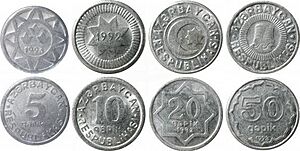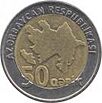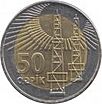Azerbaijani manat facts for kids
Quick facts for kids Azerbaijani manat |
|||||
|---|---|---|---|---|---|
|
|||||
| ISO 4217 Code | AZN | ||||
| User(s) | |||||
| Inflation | 8.8%, December 2023 | ||||
| Source | [1] | ||||
| Subunit | |||||
| 1⁄100 | Gapik | ||||
| Symbol | ₼ | ||||
| Plural | The language(s) of this currency does not have a morphological plural distinction. | ||||
| Coins | 1, 3, 5, 10, 20, 50 gapiks | ||||
| Banknotes | |||||
| Freq. used | ₼1, ₼5, ₼10, ₼20, ₼50, ₼100, ₼200 | ||||
| Rarely used | ₼500 | ||||
The manat (its special code is AZN; its symbol is ₼) is the money used in Azerbaijan. It is split into 100 smaller parts called gapiks.
The first version of the manat was used in Azerbaijan between 1919 and 1923. Back then, the money lost its value very quickly. This is called hyperinflation. Because of this, it was replaced by other types of money, like the Transcaucasian ruble and then the Soviet ruble.
When Azerbaijan became independent from the Soviet Union, it started using the manat again. This new manat also faced high inflation at first. But the manat we use today has been around since 2006. That's when the old manats were replaced with new ones that had different designs and lower values. The manat is usually linked to the US dollar. Today, about ₼1.70 is equal to US$1.
The special symbol for the Azerbaijani manat, ₼, was added to computers and phones in 2013. Before that, people often just used a small letter "m" if the symbol wasn't available.
Contents
What Does "Manat" Mean?
The word "manat" comes from the Latin word "monēta" and the Russian word "монета" (which means "coin"). This word was also used for the Soviet ruble in the Azeri and Turkmen languages.
The First Manat (1919–1923)
Between 1919 and 1923, Azerbaijan had its own money called the manat. It was called "manat" in Azerbaijani and "ruble" in Russian. The money notes had both names on them, and sometimes French too! This manat replaced an older type of money called the Transcaucasian ruble. Later, it was replaced by a new Transcaucasian ruble when Azerbaijan joined a larger group of Soviet republics. Only paper money was made for this first manat; there were no coins.
Banknotes of the First Manat
The first government of Azerbaijan printed notes for 25, 50, 100, 250, and 500 manats. Later, the Soviet government in Azerbaijan printed much larger notes, from 5 manats all the way up to 5 million manats!
The Second Manat (1992–2006)
The second version of the manat was introduced on August 15, 1992. It replaced the Soviet ruble. One new manat was worth 10 Soviet rubles.
From 2002 to 2005, the value of the manat was quite stable against the US dollar. But in 2005, its value started to go up. This was likely because Azerbaijan was selling more oil, and oil prices were high around the world. By 2005, small banknotes (under 100 manats) and gapik coins were hardly used because they were worth so little.
Coins of the Second Manat
Coins were made in 1992 and 1993 for 5, 10, 20, and 50 gapiks. Some early coins were made of brass and cupronickel. Later, they were all made of aluminum. These coins were not often used in daily life.
Banknotes of the Second Manat
Many different banknotes were printed for this version of the manat. They ranged from 1 manat to 50,000 manats. The 1, 5, 10, and 250 manat notes were first printed in 1992. Larger notes like 50, 100, 500, and 1,000 manats came out in 1993. Even bigger notes, like 10,000 and 50,000 manats, were issued in 1994 and 1996. Many of these notes featured the Maiden Tower in Baku.
The Third Manat (Since 2006)
On January 1, 2006, a brand new manat was introduced. This new manat (code AZN) replaced the old one. One new manat was worth 5,000 old manats! To help people get used to it, prices were shown in both old and new manats for a few months. Also, gapik coins, which hadn't been used for a long time due to inflation, were brought back.
The Manat Symbol
The new banknotes and the special manat symbol (₼) were designed by Robert Kalina in 2006. He also designed the euro banknotes! The manat symbol looks a bit like the euro sign (€), but turned on its side. It was added to computer systems in 2013. In Azerbaijan, the manat symbol is usually placed after the amount, like "100₼".
The Manat Code
When the new manat was first added to the international currency list (ISO 4217) in 2005, it was given the code AYM. But this was changed to AZN a few months later. This is because currency codes usually start with the two-letter country code, and "AZ" is the code for Azerbaijan.
Coins of the Third Manat
Today, you can find coins for 1, 3, 5, 10, 20, and 50 gapiks. Many of these coins look and feel similar to euro coins. For example, the 50 gapik coin is made of two different metals, just like the €2 coin. The 10 gapik coin has a unique shape, similar to the 20 euro cent coin. These coins were first used in January 2006 and do not have a year printed on them.
| Image | Value | Technical parameters | Description | |||||
|---|---|---|---|---|---|---|---|---|
| Obverse | Reverse | Diameter | Mass | Composition | Edge | Obverse | Reverse | |
| 1 gapik | 16.25 mm | 2.8 g | Copper-plated steel | Plain | Map of Azerbaijan, country name, value | Traditional musical instruments, denomination left | ||
| 3 gapiks | 18 mm | 3.45 g | Smooth with a groove | Books and quill, denomination above | ||||
| 5 gapiks | 19.75 mm | 4.85 g | Reeded | The Maiden Tower, denomination below | ||||
| 10 gapiks | 22.25 mm | 5.1 g | Brass-plated steel | Smooth with seven indentations | Military helmet of the region of Nagorno-Karabakh, denomination left | |||
| 20 gapiks | 24.25 mm | 6.6 g | Segmented reeding | Spiral staircase, Geometry & Geometrical symbols, denomination left | ||||
| 50 gapiks | 25.5 mm | 7.7 g | Bi-Metallic Brass-plated steel center in Stainless Steel ring | Reeding over lettering (AZƏRBAYCAN RESPUBLIKASI) | Two oil wells, denomination left | |||
Banknotes of the Third Manat
The banknotes you see today are ₼1, ₼5, ₼10, ₼20, ₼50, ₼100, ₼200, and ₼500. They were designed by the same person who designed the euro banknotes, Robert Kalina. The designs on the notes are inspired by different themes from Azerbaijan.
In 2009, the National Bank of Azerbaijan changed its name to the Central Bank of Azerbaijan. Newer banknotes (like the ₼1, ₼5, and ₼100 notes) have the new bank name printed on them.
In 2018, a special ₼200 banknote was released to celebrate the 95th birthday of Heydar Aliyev, an important figure in Azerbaijan's history.
In 2021, some banknotes (₼1, ₼5, and ₼50) got a fresh new look, but they kept their original themes. These updated notes are used alongside the older ones. A new special ₼500 banknote was also introduced in 2021.
2005 Series Banknotes
| Image | Value | Dimensions | Main Color | Description | Year | ||
|---|---|---|---|---|---|---|---|
| Obverse | Reverse | Obverse | Reverse | ||||
| ₼1 | 120 × 70 mm | Grey | Theme: Culture Azerbaijani folk music instruments (daf, kamancheh, tar) |
Ornaments of regional carpets | 2005 | ||
| 2009, 2017 | |||||||
| ₼5 | 127 × 70 mm | Orange | Theme: Writing and literature Writers, poets, and books from Azerbaijan, with a written part of the national anthem |
Rock drawings of Gobustan, old Turkic writing | 2005 | ||
| 2009, 2017 | |||||||
| ₼10 | 134 × 70 mm | Teal | Theme: History Old Baku, the Palace of the Shirvanshahs and the Maiden Tower with the Icheri Sheher wall |
Ornaments of regional carpets | 2005 | ||
| 2018 | |||||||
| ₼20 | 141 × 70 mm | Green | Theme: Karabakh Symbols of power (a sword, a helmet and a shield) |
Symbol of peace (harybulbul flower) | 2005 | ||
| ₼50 | 148 × 70 mm | Yellow | Theme: History and future Youth, stairs (for progress), the sun (for force and light) and science symbols |
Ornaments of regional carpets | 2005 | ||
| ₼100 | 155 × 70 mm | Mauve | Theme: Economy and development Buildings from old times to today, the manat symbol (₼) and symbols of economic growth |
Ornaments of regional carpets | 2005 | ||
| 2013 | |||||||
| ₼200 | 160 × 70 mm | Blue | Theme: Modern architecture The Heydar Aliyev Center, Baku |
Ornaments of regional carpets | 2018 | ||
2020 Refurbished Banknotes
| Image | Value | Dimensions | Main Color | Description | Year | ||
|---|---|---|---|---|---|---|---|
| Obverse | Reverse | Obverse | Reverse | ||||
| ₼1 | 120 × 70 mm | Grey | Theme: Culture Azerbaijani folk music instruments (daf, kamancheh, tar) |
Map of Azerbaijan | 2020 | ||
| ₼5 | 127 × 70 mm | Orange | Theme: Writing and literature Writers, poets, and books from Azerbaijan, with the lyrics of the full national anthem |
||||
 |
₼10 | 134 × 70 mm | Teal | Theme: History
Old Baku, the Palace of the Shirvanshahs and the Maiden Tower with the Icheri Sheher wall |
2022 | ||
 |
 |
₼20 | 141 × 70 mm | Green | Theme: Karabakh Symbols of power (a sword, a helmet and a shield) |
2022 | |
| ₼50 | 148 × 70 mm | Yellow and brown | Theme: History and future Youth, stairs (for progress), the sun (for force and light) and science symbols |
2020 | |||
| ₼500
(special note) |
165 × 70 mm | Brown, red, green and blue | Theme: The 2020 Karabakh War Poppies, Khodaafarin stone bridges |
Mausoleum of Molla Panah Vagif; Askeran fortress | 2021 | ||
Exchange Rates
Here's how the manat has been valued against the US dollar over time:
- Before February 2015: US$1 was worth about ₼0.78
- February - December 2015: US$1 was worth about ₼1.05
- December 2015 - April 2017: The value changed a lot.
- May 2017 onwards: US$1 has been fixed at ₼1.7. This is called a currency peg.
| Current AZN exchange rates | |
|---|---|
| From Google Finance: | AUD CAD CHF EUR GBP HKD JPY USD RUB TRY GEL |
| From Yahoo! Finance: | AUD CAD CHF EUR GBP HKD JPY USD RUB TRY GEL |
| From XE.com: | AUD CAD CHF EUR GBP HKD JPY USD RUB TRY GEL |
| From OANDA: | AUD CAD CHF EUR GBP HKD JPY USD RUB TRY GEL |
| From fxtop.com: | AUD CAD CHF EUR GBP HKD JPY USD RUB TRY GEL |
Images for kids
See Also
 In Spanish: Manat azerbaiyano para niños
In Spanish: Manat azerbaiyano para niños
- Central Bank of Azerbaijan
- Turkmenistani manat
- Economy of Azerbaijan
- Banking in Azerbaijan








































































